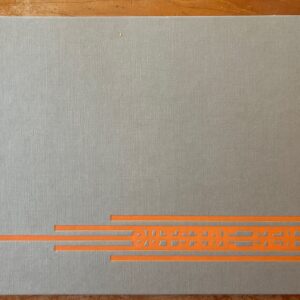JTF (just the facts): Published in 2019 by Perimeter Editions (here). Unbound softcover with elastic cord, 30.5×20 cm, 36 pages, with 34 black and white reproductions. There are no texts or essays included. In an edition of 250 copies. Design by Sasha Taylor and the artist. (Cover and spread shots below.)
Comments/Context: When we are told an object was once owned (or touched, or even liked) by a famous person, or a place was the site of something historic (or magical, or terrible), those objects and places take on special characteristics in our minds, as though they have been infused with some invisible essence. The fact that President George Washington once slept in some bed in colonial New England somehow gives that humble room a special presence, as if by visiting that place we can somehow associate with or feel the power of that centuries old connection.
Sarah Walker plays with this association effect in her photobook Pelči Manor. From the outside, Pelči Manor (located in the Latvian town of Kuldīga) looks like countless other 19th century European palaces – it’s an art nouveau brick building with a steep roof, set on lushly landscaped grounds. But its more important significance lies in that it is the site where Latvia ceded independence to Nazi occupation during World War II, and it’s this grim historical echo that the Australian photographer visually explores in her photobook.
Walker spent three days making photographs at Pelči Manor, but what we’re shown isn’t images of the reception rooms, or the formal entry, or even the bedrooms – her photobook is filled entirely with pictures from the unfinished attic. The hollow area underneath the roof is supported by a tangle of thick wooden beams, posts, struts, and trusses, accessed by wooden staircases and ladders, and absent any windows, the space is completely dark. Using a bright flash, Walker made dozens of images of the attic space, blasting the structured geometries of support system into flared and shadowed whiteness.
Many photographers, particularly the 20th century Modernists (like Sheeler, Weston, Evans, and others), have made elegant studies of attics, staircases, and interior roofs, highlighting the crisp lines and elemental forms of the geometries found there. Walker’s photographs both recall those pictures, but then go on to fill the empty, echoing attic space at Pelči Manor with a different, more haunted quality. Several of her photographs peer steeply up into the wooden structure, the angled beams jutting in all directions and the staircases zigzagging back and forth in disorienting directions. She then gets in closer, pulling overlapped beams right into the foreground, flattening the layers of structure into intricate interlocked forms. The best of these compositions are dizzying, their sharp angles and contrasts of light and dark coming together in satisfying abstract complexity.
But Walker’s interest goes beyond the strict geometries of structural carpentry. Playing with the leftover objects seemingly scattered at random around the vacant attic space, she has created the visual tension of an amateur horror film. Disembodied footsteps walk up the dusty stairs. Sawn logs are puzzlingly leaning against a wall. A single chair stands empty in an open area, marked by a disturbing stain nearby. A headless white bird lies on the floorboards. A strange handcrafted totem of evergreen branches hangs on a string from the ceiling. And several pieces of furniture (an armoire, a lamp) have been covered with sheets or hanging cloths, giving them an even more sinister what-might-be-lurking-inside edge. Walker then follows these with refrains of a few of the objects, the chair now toppled over and the sawn logs now arranged in a different pattern, making us wonder about who or what might be moving these things around in the darkness.
This is where the history of Pelči Manor comes back into play. Walker’s images turn the attic into a claustrophobic, uneasy space, where the ghosts of the past may indeed be living and the fateful decisions of history feel heavy. Even the scrawls of graffiti that decorate some of the beams and roof tiles seem to reach out to us from a violent past, the names like clues to untold stories.
As a photobook object, Pelči Manor makes smart use of an unbound construction approach. Each sheet has two full bleed images on one side and two on the other, so when they are folded together, the page turns function normally; but the looseness of the pages gives the book a more elusive, improvised feel, and the flash lit surfaces in the photographs seem to wander and intermingle, turning the flow of imagery into one integrated experience. The cover uses bold black text for the artist’s name and book title, the words seemingly carved out of the ominous darkness of the attic.
That Walker could conjure so much spookiness out of a confined space is a testament to her artistic problem solving skills. Pelči Manor has plenty of moments of engaging geometric expressiveness, but it’s the lingering mood of anxiety and distress that seems to haunt these corners that makes Walker’s photobook so memorable.
Collector’s POV: Sarah Walker does not appear to have consistent gallery representation at this time. As a result, interested collectors should likely follow up directly with the artist via her website (linked in the sidebar).















